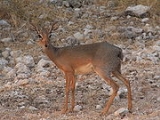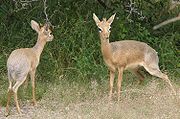
Kirk's Dik-dik
Encyclopedia

Antelope
Antelope is a term referring to many even-toed ungulate species indigenous to various regions in Africa and Eurasia. Antelopes comprise a miscellaneous group within the family Bovidae, encompassing those old-world species that are neither cattle, sheep, buffalo, bison, nor goats...
found in eastern and southwestern Africa
Africa
Africa is the world's second largest and second most populous continent, after Asia. At about 30.2 million km² including adjacent islands, it covers 6% of the Earth's total surface area and 20.4% of the total land area...
. It grows to 70 centimetres (27.6 in) in length and weighs up to 7 kilograms (15.4 lb) when full grown. It has a reddish-brown head and a tail that is 35 centimetre long.
It has a soft, grizzled gray to brown coat, and eats a wide range of plant
Plant
Plants are living organisms belonging to the kingdom Plantae. Precise definitions of the kingdom vary, but as the term is used here, plants include familiar organisms such as trees, flowers, herbs, bushes, grasses, vines, ferns, mosses, and green algae. The group is also called green plants or...
s. It has hooves with rubbery bottoms, which are effective when traveling over rocky terrain
Terrain
Terrain, or land relief, is the vertical and horizontal dimension of land surface. When relief is described underwater, the term bathymetry is used...
. Newborns are hidden for 2–3 weeks, and suckle for 3–4 months.
Genetic and behavioural evidence suggests that Kirk's Dik-dik exhibits fidelity in monogamous behaviour. Genetic analysis of off-spring indicate little non-pair parentage. Year-round, Kirk's Dik-diks stay close within pairs, follow each other's activity patterns and spend more than half of their time with their partners, although males give no parental care. The males guard their mates closely during oestrus and over-mark all female scent. This behaviour reduces the likelihood of other males attempting to mate, however, males do attempt to mate with other females on occasion. Genetic monogamy in dik-diks is probably best explained by the behaviour of females: in contrast to many monogamous female birds, female dik-diks do not appear to seek to mate outside the pair-bond.
Subspecies
Usually four subspecies of Kirk's Dik-dik are distinguished, but in fact they may represent three or more distinct species:- M. k. kirkii
- M. k. cavendishi (ThomasOldfield ThomasOldfield Thomas FRS was a British zoologist.Thomas worked at the Natural History Museum on mammals, describing about 2,000 new species and sub-species for the first time. He was appointed to the Museum Secretary's office in 1876, transferring to the Zoological Department in 1878...
, 1898) – Cavendish's Dik-dik - M. k. damarensis – Damara Dik-dik
- M. k. hindei

